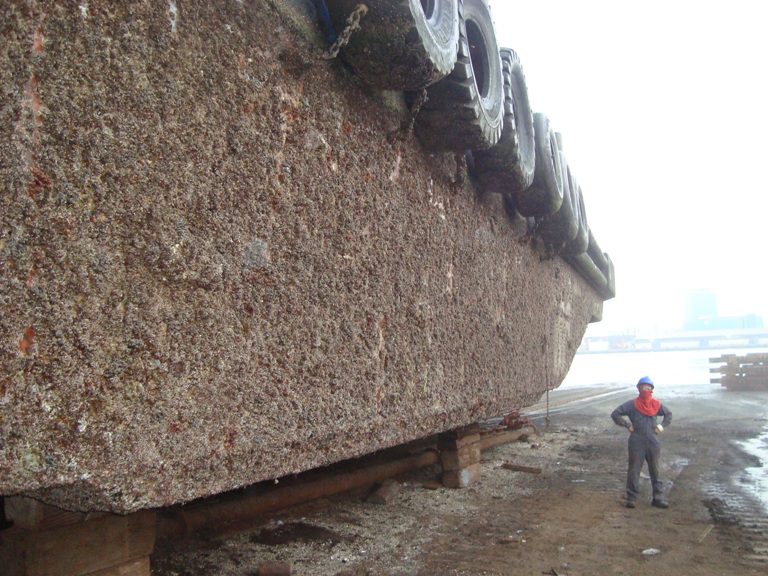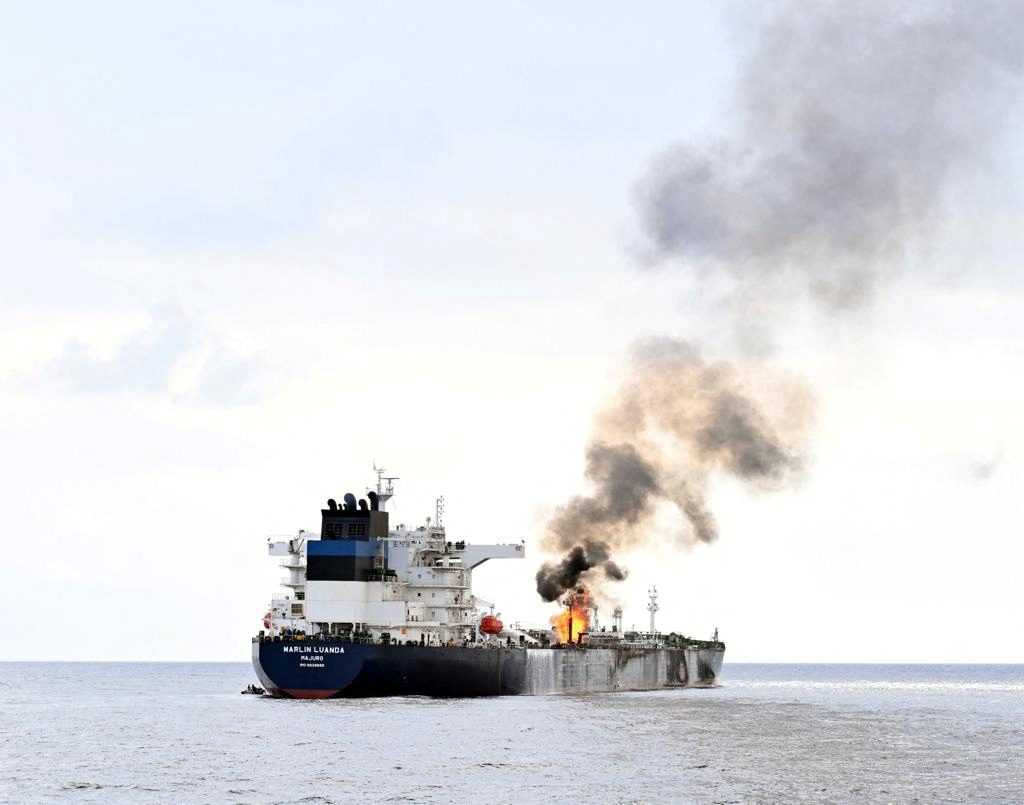Image courtesy Micanti
In the absence of hull fouling control systems, within six months of active service a vessel could have up to 150 kilograms of marine life per square meter attached to the hull. This obviously has huge fuel efficiency and bunker fuel cost implications. Even minor volumes of fouling can impact fuel efficiency by up to 40%. Therefore, reducing drag, or skin frictional resistance is vitally important to reducing ever-increasing bunker fuel costs. Loss of speed from moderate fouling, though less important in the age of super slow-steaming, can range between 10% to 18%.
This week, Fathom looks at the great era of innovation and technological development within the hull coatings and hull maintenance markets in the advent of stricter environmental regulations, heightening bunker fuel costs and research showcasing the immense impact of hull drag or resistance on bunker fuel consumption.
The Research and Statistics
A report compiled in 2011 by Dr Michael P Schultz conveyed the message:
“Ship owners: Paint now, or pay later”
Schultz’s pioneering research quantified, for what was perhaps the first time, the economic consequences of drag from ship hull fouling.
The study looked at the hull fouling penalty for the U.S. Navy’s conventionally powered, mid-sized surface combatant: the Arleigh Burke-class destroyer (DDG-51). The study examined 320 actual individual inspection reports from Jan. 1, 2004, to Dec. 31, 2006.
It was found that resistance due to hull fouling amounted to US $56 million per year for a DDG-51 class destroyer, and about US $1 billion over 15 years.
His conclusion from the studies was: The main cost associated with fouling is the increased fuel consumption from increased frictional drag.
“The costs related to hull cleaning and painting are much lower than the fuel costs,” Schultz reports in “Economic Impact of Biofouling on a Naval Surface Ship,” published in the journal Biofouling.
Furthermore, Schultz said, a hull needn’t be fouled to drag. Even when the hull is free of fouling, frictional drag on some hull types can account for up to 90% of total drag, he reported.
Innovation Dampens Doubts
With hull resistance and drag having such an immense impact of bunker fuel consumption, ship owners and operators are looking for hull coatings and cleaning solutions that deliver the highest impact on drag reduction. The advent of heightening bunker fuel prices and stricter environmental regulations around the maritime industry has without a doubt spurred a great era of innovation within the industry.
However, this era of innovation also came with doubts surrounding the hull coatings market from within the industry. Notably, the banning of TST-based paints left many ship operators disenchanted and convinced that the industry has failed to provide an alternative of sufficient quality.
Also, some copper-based paints were designed for ships in operation. Once overtonnage hit its high and freight rates their low many ships were docked, and as a result the biocidial release mechanism was no longer effective, resulting in expensive biofouling.
There are also indications that copper-based paints will also come under regulatory scrutiny, with the U.S. State of Washington outlawing its use with effect from 2018.
However, in light of previous hull coatings solutions being hit by regulation or even banned, in addition to the industry’s perceptions of the hull coatings market and the industry’s need for superior, more proficient coating solutions, a number of research projects and innovative solutions have broken out on to the market in recent years.
The Advent of Innovative Hull Coating Solutions
One hull coating solution, currently in development, is a unique coating concept devised by Duke University that quite literally ‘shakes off’ any would-be residents.
Engineer Xuanhe Zhao and his colleagues from Duke University are behind the development of the coating. “Under external stimuli, such as electric voltage or air pressure, the active polymer coating can deform, forming patterns such as wrinkles, creases and craters,” Zhao explained.
The changes in the shape of the hull surface on a minute level mean that biofilm will be detached. This is also a pre-emptive strike against larger organisms, which attach to the hull precisely so that they can feed off of this biofilm layer.
The coating is currently in the testing stages within a laboratory with simulated seawater and further investigation is currently underway. “The new mechanism of active anti-fouling is under intensive investigation in our group and other research groups,” Zhao confirmed.
“We still need to improve the long-term reliability of the active coating and reduce its cost,” he explained. “We also do not know how long the new coating will last in applications, but we are actively testing this now.”
In February 2013, International Paint launched two innovative hull coatings that they claim rival the old TST market favourites.
International Paint’s Intercept® 8000 LPP provides predictable linear polishing performance, which is “like going back to the good old days of tin” Colin Anderson, Business Manager of Anti-foulings (1993-2006) commented.
The key to the coating’s success is the patented Lubyon® polymer which is superhydrophilic to create a lubricating effect on the hull surface that swells on contact with water and helps to smooth out irregularities in the hull surface. The lubricating effect means a very low friction surface throughout the lifetime of the coating that results in reduced fuel and emissions savings of up to 5% annually (average, compared to typical controlled depletion polymer).
Meanwhile, their Intersleek 1100 SR product offers a unique slime-release protective coating that resists the development of marine slime, Extracellular Polymeric Substances (EPS) or biofilms, by simply being too sleek for micro-organisms to settle on the vessel’s hull.
Hempel’s Antifouling Globic NCT 8190M also offers self-smoothening and self-polishing antifouling capabilities, and is based on nanocapsule acrylate binder technology which makes the coating suitable for even aggressively fouling waters such as the tropics.
Since 2007, Nippon Marine has offered the market LF-Sea, which is based on Silyl-Copper Acrylate Hydrolysis technology and is a self-polishing antifouling paint that relies on patented water encapsulation with a savings claim of 4%. Added conveniences of the product are a 5 year service life and the fact that it is applicable over existing antifouling paints, thereby eliminating the need for blasting.
Micanti’s Thorn D antifouling meanwhile, like many other coatings and hull performance solutions in the sector, is a move away from biocidal and toxic solutions. Similar to the Duke University Paint, the product places the focus not on the chemistry of the coating but on the shape of the surface. The coating is in actual fact a self-adhesive foil so that the ship owner ‘wall papers’ rather than paints their hull. The result is a physical barrier against marine growth such as mussels and barnacles that uses specific short fibres that prevent the settlement of fouling by turning the hull into an undesirable surface.
Ship Owners + BIMCO’s New Hull Fouling Clause
Who looks after the hull coating has always been a key question between ship operators and owners, and the standard is for the owner to maintain the vessel throughout the charter period.
BIMCO’s new clause tackles the hull fouling dilemma.
Under most standard forms of time charter party an owner is obliged to maintain his vessel throughout the charter period. Such maintenance includes keeping the vessel’s hull and other underwater parts free of fouling. If the owners fail to maintain the vessel and, as a result, the vessel’s performance is affected, the owners may be exposed to claims by the charterers for underperformance. With modern efficient hull coatings and relatively swift turnarounds in port, fouling should not be a major issue.
However, the owner’s maintenance obligation is based on the “normal” operation of the vessel that includes port stays of a reasonable determinable duration. If the charterers order the vessel to a port or place where it sits for a period in excess of what might be considered a “normal” duration and this results in hull fouling, should the owners still have to continue to warrant the performance of the vessel?
Rider clauses dealing with hull fouling have been in widespread use in a number of trades for many years. They are generally fairly simplistic, stating only that if the vessel lies idle for more than an agreed number of days then the owners can suspend the performance warranty until the hull has been cleaned. Sometimes the costs for cleaning are passed to the charterers, but not always. As a result there is an inconsistent approach in the industry to dealing with hull fouling following prolonged stays in port on charterers’ orders. As the length of port stays has increased in recent years, this has often become a source of dispute between owners and charterers.
BIMCO has tackled this issue with a new Hull Fouling Clause which comprehensively sets out the physical circumstances and the point in time when the responsibility for hull fouling passes from the owners to the charterers.
The clause distinguishes between idling in Tropical Zone waters, where the rate of growth is generally highest, and idling outside this zone. The parties are free to agree the number of days idling to apply in each area before the clause takes effect. If they cannot agree then 15 days applies by default.
Once the agreed number of days has lapsed, the vessel’s performance warranties are suspended until such time as the hull can be inspected and, if necessary, cleaned. It may well be that inspection and cleaning is not possible or permitted at the vessel’s current port of call – and the clause deals with this situation. If the hull is fouled then it is to be cleaned by the charterers at their cost and in their time – but in accordance with the paint manufacturers’ recommendations and under the supervision of the Master. This recognises that hull coatings are very expensive, easily damaged and become less effective the more often they are cleaned.
Finally, if it is not possible to clean the hull before the vessel is redelivered, then the clause provides for the owners to be compensated for the costs they will incur when eventually cleaning the hull.
The BIMCO Hull Fouling Clause has been drafted by a team of owners and charterers to ensure that the provision is appropriately balanced. Valuable technical input was provided by a representative from a major paint manufacturer. The Clause was adopted by the Documentary Committee at its meeting held on 27 May 2013 in Paris.
The Clause, along with a short explanatory note, will be issued by Special Circular to members towards the end of June and will be available to download free of charge from the BIMCO website at www.bimco.org.
Conclusion
In the advent of the push for unique innovative fuel saving solutions, the hull coatings sector’s profile will continue to heighten and the time is perfect: It is a sector that has fully recovered from the previous set back of having TST-based paints banned and is thriving from years of investment in R&D.
In recognition of the importance of hull coatings to ship eco-efficiency, Fathom is currently in the research phase of producing its second issue of Fathom FOCUS on hull coatings. Fathom FOCUS is a free in-depth magazine on one eco-efficiency issue in particular, unlike the flagship publication Ship Efficiency: The Guide Second Edition, which prides itself on offering a 360 degree look at the industry’s offerings.
The second Fathom FOCUS publication will shine a spotlight on the hull fouling control market, entitled Choosing Optimum Lubricant Solutions for Your Operation, the publication will be available at Ship Efficiency: The Event as part of London International Shipping Week. Tickets for the event are available here.
For more news and tips on efficient shipping, please visit Fathom cTECH!
Unlock Exclusive Insights Today!
Join the gCaptain Club for curated content, insider opinions, and vibrant community discussions.

 Join The Club
Join The Club













